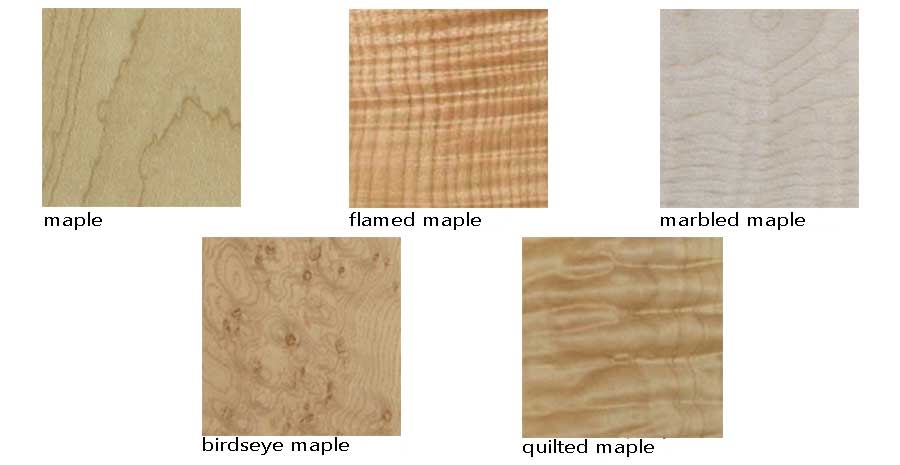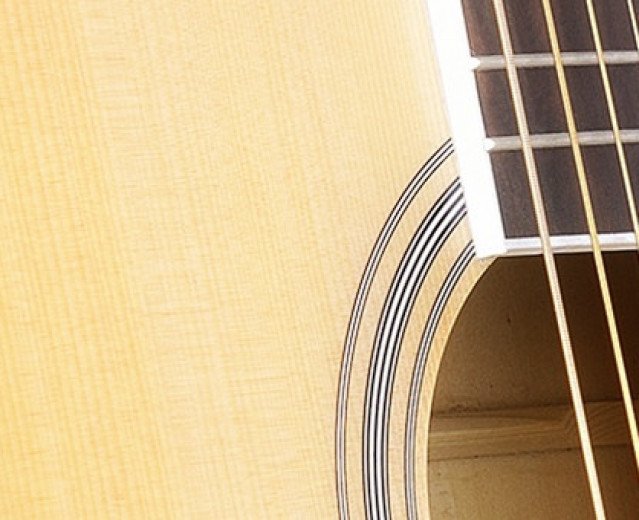hich woods are used for the construction of acoustic guitars?
The quality
of the woods plays a fundamental role in the construction of an acoustic
instrument. As for electric instruments, different woods are used for the body,
the neck and the freatboard. Each one has peculiar physical, sonic, and
esthetical characteristics, and costs can range widely depending on the quality
of different tonewoods. Wood seasoning is very important: green wood does not
have satisfactory sonic qualities and will certainly shrink during the natural
process of seasoning. As other factors, like the kind of wood grain (open,
closed, even, uneven), the seasoning, the bracing system, all influence the final
sound of the instrument, the type of wood is just one among the many aspects
contributing to the global sound. In other words, it is not possible to predict
precisely how a guitar will sound knowing only the woods used. Our
classification of woods will be based on their use, that is, the wood used for
the top (or soundboard), and those used for sides and bottom.
The top (or Soundboard)
Spruce
and cedar are the most frequently used woods for the soundboard of an acoustic
guitar.
Spruce
This
is the most common wood used for the tops, it is highly resonant, and has a
well balanced and bright tone. Usually light coloured, the sound improves over
the time, as spruce wood changes during the life of the instrument. The different kinds of
spruce used for soundboards are:
- Sitka spruce: highly resonant, clear, crisp and full tone, with a bright mid-range. The dense and even grain guarantees a fast response. It is the most used spruce.
- European spruce: less aggressive sounding than the Sitka, shows a very well balanced tone, with more rounded mids and lows and particularly harmonically rich. Renowned for its resonance (especially the timber coming from central and east areas), it is preferred for finger-style and is used for the construction of pianos and violins too.
- Englemann spruce: its sound is very close to those of the most expensive spruces (red spruce or Adirondack), with a more prominent bass and marked mids, together with the classic brightness of the spruce on the higher frequencies. Compared to Sitka, offers a faster response and sounds louder. Very appreciated for finger-style and flatpicking.
- Red spruce (Adirondack): the favourite spruce by collectors, very rare and valuable. Combines the snappy attack of the Sitka with the harmonic complexity of the European spruce, with a fast response due to greater elasticity. The best choice for flatpicking, and by all accounts the only spruce able to recreate the vintage sound of the famous guitars built before the 40’.
- Douglas spruce: very similar to Sitka spruce, but with a more rounded tone. Very well balanced sound and a very fast response.
 Stika Spruce
Stika Spruce
Cedar
The
wood used as an alternative to spruce is cedar. Cedar sounds more rounded,
softer and warmer than the spruce, that on the other hand offers a more opened
and brighter tone, with more definition and loudness. That’s why we say “cedar
is for the players and the spruce is for the listeners”. Moreover cedar does
not change with the passing of time, consequently its tonal qualities will not
improve during the life of the instrument as often happens with spruce (according
to someone, cedar looses part of its global richness, but this is not always
the case). Aesthetically, the difference between spruce and cedar is obvious, the
latter being darker and reddish. Broadly speaking, who is looking for a
more aggressive sound can usually prefer
the spruce, but this is true only if other construction feature are the same. As a matter of fact, the
sound of the guitar is also influenced by the shape, the bottom, the sides and
the brace. For the soundboard of acoustic guitars, the Spanish cedar is preferable, usefully combined with rosewood, ovangkol or walnut sides. Sonically
can be compared to sitka spruce, but with less transparency and harmonic separation.
The red cedar is more suitable for
the classic guitar, but can be a good choice for acoustic instruments used for finger-style,
thanks to its bass-focused tone but nevertheless bright sounding at the same
time. To express its tonal qualities at their best, red cedar must be cut into
thin boards, consequently it is suitable for guitars equipped with thin gauged
strings.
 Spanish Cedar
Spanish Cedar
Bottom and sides
The
most common woods used in the construction of bottom and sides are rosewood and mahogany. Maple is frequently
used too, mainly because of its beautiful figures, and the open and loud tone. Other
tonewoods more rarely used for bottom and sides of the acoustic guitars are the
ovangkol, the koa, the zebrano, the walnut (just to mention some).
Rosewood
It is a
valuable and expensive wood (especially the Brazilian one), very strong and
heavy. This translates in a warm and rounded sound, together wit a long sustain,
qualities that make it suitable for flatpicking and bluegrass guitars. Especially
beautiful, with noticeable grain and brownish coloured.
The Indian rosewood, less valuable than the Brazilian one for availability
reasons (but sonically equivalent or even superior) shows more porosity, a
darker colour, and less noticeable grain, that looks more even and parallel.
 Indian Rosewood
Indian Rosewood
Mahogany
Mahogany
is lighter and usually less expansive than rosewood. Aesthetically has a
typical red colour, sometimes with valuable figures. Broadly speaking, an acoustic
guitar with mahogany bottom and sides sounds usually more sweetly and focused
on the mid frequencies than a guitar with rosewood bottom and sides. Mahogany
guitars are preferred by musicians using the bottleneck technique. Some acoustic
guitars are entirely built in mahogany, often combined with an open pore or
satin finish.
 Mahogany
Mahogany
Maple
Maple
is widely used for electric instruments (for the necks, fretboards, tops and
bodies), but is suitable for the bottom and sides of acoustic instruments too, even
if more rarely used than rosewood or mahogany. It is a beautiful wood, with its
many aesthetically appealing variances. As maple highlights the higher frequencies
in the spectrum, it is often employed to balance those instruments that would
otherwise sound too rich in the low end, like the Jumbo models, for instance. A
guitar with a maple body, even if with a poorer tone in the low end, will project
a loud sound, perfectly suitable for the typical rock strumming.
Moreover,
maple offers a beautiful aesthetical addition to any guitar, thanks to its many
figures, like quilted, flamed, tiger, bird’s eye, curly, or spalted.

Laminated or solid woods?
In the construction
of the acoustic guitar, the woods used can be solid wood (that is, made from a single piece of wood) or laminated wood, in which thin sheets of
wood (usually at least 3) are glued on top of each other so that the grain of
each layer is crossed, to increase strength.
This
reflects in the propagation of sound, that depends on two factors: elasticity
of the materials the instrument is made of, and its weight. As solid wood is
lighter and more flexible than laminated wood, the propagation of sound waves
is better when a guitar is built with this type of woods. On the other end, laminated
wood is heavier and less flexible, but is stronger. Moreover, the sonic
qualities of solid wood improves over the time, while those of laminated wood
remain stable.
Both the top and the soundbox (bottom and sides) can be made of solid or
laminated woods. The entry level models are made of laminated wood to keep costs down, while
higher quality models can use solid wood for the top, the soundbox, or the
entire instrument. Many guitars use a solid wood top together with bottom and
sides made of laminated wood, in order to combine decent sound quality with
strength and lower costs. This is not always true, as a low quality solid wood
could sound not as good as an high-quality laminated spruce, for instance (spruce
is the best sounding wood in terms of resonance, consequently is the most used
wood for the soundboards). We want also remind that a solid wood guitar is
easier to repair, as solid wood cracks, while laminated wood breaks into pieces.
The most
important elements we must take into account when choosing solid or laminated
wood are:
- Tone and resonance (solid wood is clearly superior if beyond entry level performances are needed, at least for the soundboard)
- Applications (for a guitar often used outdoor, that travels frequently, bottom and sides made of laminated wood can be preferable for their strength)
- Budget (solid woods are more expensive)
The Soundsation line of acoustic guitars
includes models made entirely of laminated woods and models wit a solid wood top.
Series using laminated wood: Yosemite, Yellowstone
Series with solid wood top: Shadow, DN, CNE
